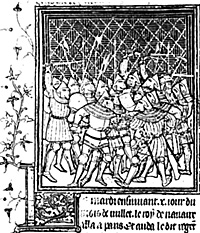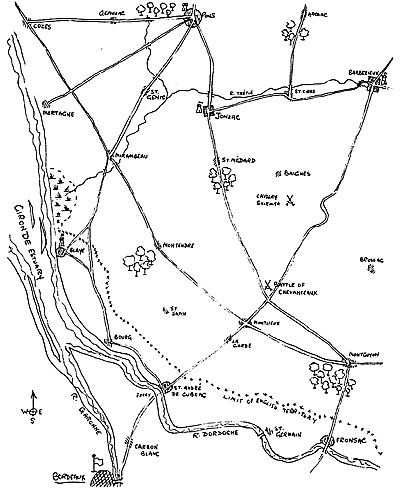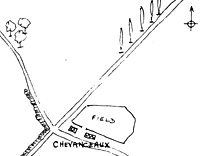 This battle was fought as a solo game taking advantage of a day when I was at home with a bad
cold. Together with the map campaign, it took the whole day,
from about 9.30 to 8.00 with a break for lunch and about 40 cups
of coffee!
This battle was fought as a solo game taking advantage of a day when I was at home with a bad
cold. Together with the map campaign, it took the whole day,
from about 9.30 to 8.00 with a break for lunch and about 40 cups
of coffee!
The map-work was based on the chapter "The Agincourt Campaign" in Don Featherstone's book.
Details can be found there by anyone who is interested, but briefly, the English army is returning to Bordeaux after a ride northward into Saintonge, (I have a feeling that they were interested in the ducats of the little town of Cognac!) pursued by the infuriated French. The latter, of course, have no difficulty in obtaining food and supplies, but the English have to rely on what they can loot from towns and villages as they pass. A looted village supplies food for one day: a town for three. The map was laid out on graph paper, and movement rates were simply so many squares per move, 8 moves constituting one day.
As the campaign opens, the English army is busily looting Archiac on the extreme northern edge of the map.
 DAY 1:
DAY 1:
The English infantry and waggons march S.E. towards Barbezieux, by country lanes, making about Jrds of the distance by nightfall, and camping in the fields. The cavalry reconnoitre to the west and south, and pass the night at St.Ciers. At the some time, the French army arrives at Pons. (This interval of 1 day is to give the English a head-start along their route).
DAY 2:
The English infantry and waggons, without food, march at 1/2 speed, arriving at Barbezieux on move 7. They are joined by their cavalry and being in overwhelming force take the town without trouble. The garrison of the castle, finding discretion to be the better part of valour, content themselves with hurling a few odd insults and crossbow-bolts, but do not sortie out. The English now have food for three days. In the meantime, the French infantry have marched south, camping near the bridge over the R. Trefle. Their cavalry, scouting ahead, have passed the night at Jonzac.
DAY 3:
The English now march cheerfully S.W. down the main road toward Bordeaux, at the best speed they can manage. The cavalry, and some waggons lead the way, and towards night, leave the road heading for Beignes. The French march on through Jonzac; and the cavalry, still ahead, reach St. Medard.
DAY 4.
English infantry march steadily all day down the road to the S.W. Meanwhile, their cavalry, with the light waggons following, take Baignes (moves 4 and 5), load up with food (moves 6 and 7) and head back S.E. for 1 move, with the cavalry now covering the rear. However, on move 8, the French cavalry also arrive in Baignes, where they learn from the disgruntled inhabitants of the whereabouts of the English. As it is already night, the French camp, and prepare to fight the next day. In the meantime, the French infantry march on steadily to the S.E.
DAY 5:
Is spent with the English infantry still marching steadily S.W. and the French steadily S.E., heading for the crossroads north of Montlieux. The race is won by the French, by a short head, as at nightfall, they camp only 1 move short of the crossroads, while the English are still 2 1/2 moves away. In the meantime, the French cavalry have overtaken the English cavalry and a brisk skirmish ensues.
The result of this is both sides being roughly equal in strength is that the Bnglish rebuff the French quite sharply, and are then content to continue on their way. The waggons have now reached a point only 2 moves behind the English infantry, who are just finishing off their food supplies. Obviously, a battle is inevitable next day. The waggons will arrive at the beginning of move 3, with breakfast: the English cavalry at the beginning of move 5. The French cavalry, by the time they have rallied, and travelled the longer distance, will appear at the beginning of move 8 only. We now move onto the table. The terrain here will be an open upland plain
 The layout of the table for
the battle is really quite
simple, the main
features being the two roads, crossing
not quite at right-angles near the
southern edge.
The layout of the table for
the battle is really quite
simple, the main
features being the two roads, crossing
not quite at right-angles near the
southern edge.
At the crossroads stands the minute village of Chevanceaux (2 houses and a stone-walled field) while for a short distance the roads are lined with thick hedges. The main road, being of Roman origins, is quite straight and partly lined with poplars. (Please do not write and tell me that they were only planted by Napoleon. I do not wish to I know that).
As the English were a couple of moves behind the French, having waited to get their breakfast, the French were already deployed along the line of the crossroad. Sir Bertrand du Guesclin, the French Constable, made the following dispositions: On his right wing was the French Van, infantry under the Comte de Dreaux with Genoese crossbowmen lining the near wall of the field. In the centre was the Standard of the Master of the Crossbows (i.e. O.C. all infantry units) the Comte de Tancarvillet with his men stretching from the corner of the field post the end of the hedge. The rear was on the left wing, under the orders of James, Earl of Douglas (the French having invoked the Auld Alliance had the assistance of a unit of Scots infantry), and the left wing and part of the centre again were covered by an extended line of crossbows.
Du Guesclin, being well on top, had actually managed to instill a certain amount of discipline into his reserve of mounted knights, which he held back behind his left centre, opposite the open ground. These knights were led by Carlos ("The Bad"), King of Navarre and Louis, Duke of Anjou.
The English forces, coming onto the field later, deployed opposite the French, who heavily out-numbered them. They had only two divisions of infantry, under Sir John Chandos, which they deployed one each side of the main road, with the archers thrown forward on the wings and in between, in the usual manner of the day. They remained well-back (which they were later to regret) as this meant that they were out of range of the crossbows. Chandos had no reserve, for the moment. His cavalry, under the Earl of Warwick and the Captal de Duch, constituted the third, and reserve, division of the army.
The battle now opened, and immediately du Guesclin was faced with a problem, because the English longbows outrange the French and Genoese crossbows, and the English began steadily to pepper their enemies at extreme range. Being a cautious man, and realising that the English could not stay where they were for long, he would have been content to retire a little, out of range, and wait them out, or harass them into surrender by preventing their foraging, but unfortunately for him, I wanted a battle, and was able to persuade some of the nobles under his command to work on him, and induce him to attack, which he did! Craftily, he ordered a general advance, but perceiving that the English left was weaker in archers then their right, he directed his centre units to angle that way.
While a furious archery duel went on in the centre between longbows and crossbows, and the French left quietly melted away under repeated volleys and being flung forward again and again against the English right, the French right wing steadily overwhelmed the English left. The English cavalry arrived just in time to prevent the whole wing from breaking and running for it, but were not strong enough to reverse the trend.
On the 8th move of the day, as dusk began to fall, du Guesolin saw the remainder of his cavalry finally appear on the western edge of the table, and he was now ready for the final blow. The victorious English right was reduced to a single line of pikemen, a dozen archers and a handful of knights, and all English reserves had already been committed. The whole of the French cavalry, held back for this supreme moment, were now hurled forward in a mighty charge.
It was the final effort either side would make - would they succeed in breaking the line? The answer proved to be yes, and the English now went down to utter disaster leaders captured, infantry and archers over-run, fugitives pursued, booty re-taken! Only Warwick and the Captal, on the far wing, succeeded in getting about two-third of the English mounted wing away reasonably intact, with an open road to Montguyon and Fronsac before them.
I am now engaged in arranging ransoms and exchanges of prisoners ready for a revenge match!
Back to Table of Contents -- Wargamer's Newsletter # 125
To Wargamer's Newsletter List of Issues
To MagWeb Master Magazine List
© Copyright 1972 by Donald Featherstone.
This article appears in MagWeb.com (Magazine Web) on the Internet World Wide Web.
Other articles from military history and related magazines are available at http://www.magweb.com